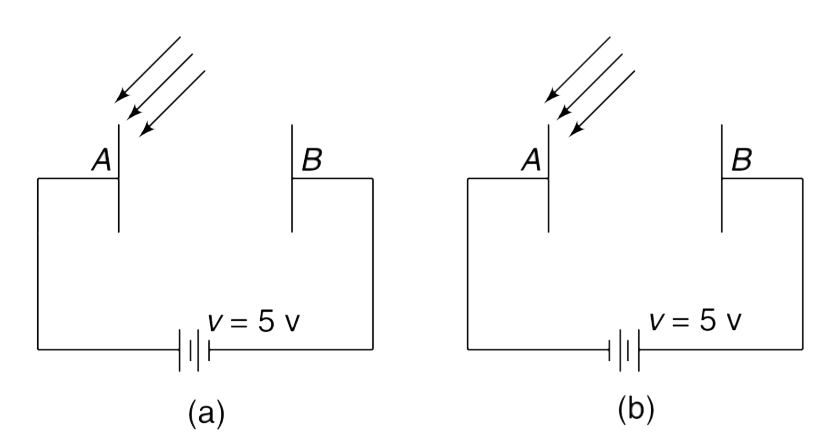The maximum kinetic energy of electrons in a photocell is 5.5 eV. Calculate the stopping potential .
To solve the problem of calculating the stopping potential given the maximum kinetic energy of electrons in a photocell, we can follow these steps:
1. Understand the relationship between kinetic energy and stopping potential:
The maximum kinetic energy (K.E.) of the electrons emitted from the photocell is related to the stopping potential (V_s) by the equation:
K.E.=e⋅Vs
where e is the charge of the electron (approximately 1.6×10−19 coulombs).
2. Identify the given values:
From the problem, we know that the maximum kinetic energy of the electrons is:
K.E.=5.5eV
3. Substitute the known values into the equation:
Since we are looking for the stopping potential Vs, we can rearrange the equation:
Vs=K.E.e
However, since we are working in electron volts (eV), we can directly equate the kinetic energy in eV to the stopping potential in volts:
Vs=K.E.
4. Calculate the stopping potential:
Therefore, substituting the value of kinetic energy:
Vs=5.5eV
5. Final answer:
The stopping potential Vs is:
Vs=5.5V
Summary:
The stopping potential is 5.5 volts.
The maximum kinetic energy (K.E.) of the electrons emitted from the photocell is related to the stopping potential (V_s) by the equation:
K.E.=e⋅Vs
where e is the charge of the electron (approximately 1.6×10−19 coulombs).
From the problem, we know that the maximum kinetic energy of the electrons is:
K.E.=5.5eV
Since we are looking for the stopping potential Vs, we can rearrange the equation:
Vs=K.E.e
However, since we are working in electron volts (eV), we can directly equate the kinetic energy in eV to the stopping potential in volts:
Vs=K.E.
Therefore, substituting the value of kinetic energy:
Vs=5.5eV
The stopping potential Vs is:
Vs=5.5V
The stopping potential is 5.5 volts.
Topper's Solved these Questions
- DUAL NATURE OF RADIATION AND MATTER BOOK - MODERN PUBLICATIONCHAPTER - DUAL NATURE OF RADIATION AND MATTER EXERCISE - PRACTICE PROBLEMS - 1
4 Videos
- DUAL NATURE OF RADIATION AND MATTER BOOK - MODERN PUBLICATIONCHAPTER - DUAL NATURE OF RADIATION AND MATTER EXERCISE - PRACTICE PROBLEMS - 2
10 Videos
- CURRENT ELECTRICITYBOOK - MODERN PUBLICATIONCHAPTER - CURRENT ELECTRICITYEXERCISE - Chapter Practice Test
15 Videos
- ELECTRIC CHARGES AND FIELDS BOOK - MODERN PUBLICATIONCHAPTER - ELECTRIC CHARGES AND FIELDS EXERCISE - Chapter Practice Test
15 Videos
Similar Questions
Knowledge Check
Assertion: If the maximum kinetic energy of electrons emitted by a photo cell is 5 eV, then the stopping potential is 5 V.
Reason: Stopping potential for fastest photoelectrons is numerically equal to their kinetic energy.AAssertion is True, Reason is True,
Reason is a correct explanation for Assertion.BAssertion is True, Reason is True,
Reason is not a correct explanation for Assertion.CAssertion is True, Reason is False.DAssertion is False but, Reason is True.The maximum kinetic energy of the photoelectrons is related to the stopping potential (v0) thorugh the relation
AKEmax=eV0BKEmax=e/V0CKEmax=eV20DKEmax=e√V0Assertion: Stopping potential depends upon the frequency of incident light but is independent of the intensity of the light.
Reason :The maximum kinetic energy of the photoclectrons is proportional to stopping potentialAIf both assertion and reason are ture and reason is the correct explanation of assertionBIf both assertion and reason are true but reason is not the correct explanation of assertionCIf assertion is true but reason is falseDIf both assertion and reson are false.
The maximum kinetic energy of a photoelectron is 3 eV. What is its stopping potential ?
View SolutionUltraviolet light of wavelength 280 nm is used in an
experiment on photoelectric effect with lithium
(φ=2.5eV) cathode. Find (a) the maximum kinetic
energy of the photoelectrons and (b) the stopping
potential.
View SolutionIn a photoelectric experiment, a monochromatic light is incident on the metal plate A. It was observed that with V=5volt, the maximum kinetic energy of photoelectrons striking plate B was 1eV. The polarity of the applied potential difference was as shown in figure (a). With polarity of the applied potential difference reversed (as shown in figure (b)) and frequency of incident light doubled, it was observed that in saturation state, the kinetic energy of electrons striking plate B ranged between 5 eV to 20 eV. Find the work function of metal used in plate A.

View SolutionThe maximum energy of the electrons released in photocell is independent of -
View SolutionThe maximum energy of the electrons released in photocell is independent of -
View Solution
